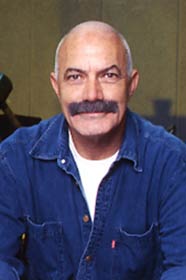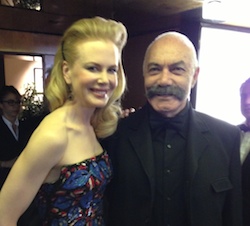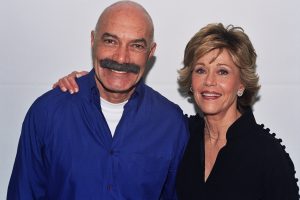While Vincente Minnelli’s trial period at Metro progressed smoothly, he had no indication whether the studio’s top brass felt he was ready to direct.
He was just a one-year apprentice, and they usually opted to go with tested talents.
Commercially proven directors, such as Sam Wood, Victor Fleming, Clarence Brown, and George Cukor, all Oscar-nominated or winning filmmakers under contract at MGM, had the first choice on the best properties. Despite his Broadway reputation, Minnelli would have to prove his movie worth all over again.
One day, producer Arthur Freed called Minnelli into his office. “What do you think of Cabin in the Sky” he asked. “I think it is true and human, a wonderful story,” Minnelli said. Showing no emotion, Freed then said, “How would you like to direct it”? Minnelli was stunned.
If Cabin in the Sky had not been a small, risky picture, Minnelli would have had to wait much longer for his directorial breakthrough
Surprisingly, he was allowed to tackle his first assignment with more freedom than he had anticipated. Minnelli was not aware until years later how hard Freed had to fight for him to get the job. He also didn’t realize the extent of Freed’s battle to get a decent budget for what the studio considered to be a second-tier film–after all, it was an all-black musical.
Minnelli was eternally grateful for this insularity–not knowing anything about studio politics–the cruel in-fighting, the heartless backstabbing was an advantage at that point.
In later years, when the studio system would collapse, Minnelli wouldn’t know how to fend for himself. Like other contract directors, Minnelli naively yet conveniently thought that the studio system and the security it provided for its talented directors would last forever.
Cabin in the Sky was the first all-black musical since King Vidor’s 1929 pioneering musical, Hallelujah!
The militant black press was critical of the endeavors all-white patronizing tone. Minnelli himself had some reservations about the story, which, intentionally or u intentionally, seemed to reinforce the then prevalent stereotypes of blacks as being naive and even childlike.
There is no denying that in Cabin in the Sky, too, the characters are marked by essential simplicity, and they also embody absolutes of good and evil, lacking nuanced shading or ambiguity. However, once he committed to the project, Minnelli decided to approach the material with passion and affection, giving no serious thought to the potentially negative reaction to a white director tackling “black material.”
Ethel Waters, who had appeared in Minnelli’s first Broadway musical, At Home Abroad, became his talisman when she agreed to repeat her stage role as Petunia.
Minnelli wanted Dooley Wilson to recreate his Broadway role as little Joe, but he was overruled since Wilsons name was not as big a name as Eddie “Rochester” Anderson’s. Had they waited a year or so, after Dooley’s great success in Casablanca, Dooley would have gotten the part.
Cabin in the Sky also offered a good part for Lena Horne. Lena had arrived at MGM at about the same time as Minnelli. She had met Minnelli in New York when they toyed with the notion of Lena playing the lead in Serena Blandish, a musical that never materialized. Bonding right away, they began socializing, and even went out on a couple of dates. Soon they became known in Hollywood as the “sophisticated, high-strung” New Yorkers.
Lena had complained to Minnelli that because she was black, her numbers were not integrated into the scripts of her films. The reason for that was simple: If Southern distributors expressed objection, the black performers songs could be easily deleted out of the film. Minnelli thought that this was a contemptible practice, but characteristically, he was too passive and powerless to raise his voice to protest.
Georgia was Lena’s first real acting role at Metro. Lena had made her film debut in Panama Hattie, essentially a Red Skelton vehicle, in which she did a number with the Berry Brothers.
One of Minnelli’s first assignments was to stage Lena’s musical numbers at what he humorously described as “minimum cost and maximum style.”
Minnelli costumed Lena in lavish gown, which featured her shapely figure marvelously, often positioning her in front of changing sets. Since her numbers were shot on a proscenium stage, he had to learn quickly how to move the camera.
Lena later said that Cabin in the Sky was the first picture in which she played a major part (equal in size to that of Ethel Waters). From the start, Minnelli made sure to offer her a great deal of confidence, and she responded with an almost blind trust.
Nonetheless, budgetary constraints did limit the potential of Minnelli’s vivid imagination. Freed decided that about half of the action would take place in Petunia’s cabin, which made the film seemed too theatrically stagy. There were too many moments that smacked of theatrical tableaux strenuously extended to the big screen, such as Little Joe and Petunia’s ascent to Heaven.
Moreover, Hell is depicted as one cramped white-deco office suite in Hotel Hades, while Heaven is represented through a painted staircase to infinity, surrounded by dry ice with black cherubs sitting on broken Greek columns.
Even so, Minnelli managed to show his stage talent by imbuing objects with the fantastic. For example, oil lamps flare with the arrival of messengers, and there is a Lacy iron bedstead on which little Joe awaits his fate.
Without Minnelli’s stylized and expressionistic direction, the film would have been too arch and simplistic. Minnelli deployed the camera’s power in shaping the distinct mood of each scene, without calling too much attention to itself.
From his first assignment, Minnelli was beginning to show the mastery of a technique that would make him the most cinematic of Hollywood’s musical (and dramatic) directors, such as his competitor, George Cukor.
Not everything went smoothly, though. Thus, Minnelli’s first contact with the art department resulted in a battle. Most debutant directors tended to accept passively the department’s rules and regulations. But Minnelli perceived it as a medieval division, too accustomed to their old-fashioned way. When the art department showed him sketches of the cabin, Minnelli’s temper, which his bland exterior usually kept hidden and under control, flared up. He told the designers that they have missed his intent in showing that the characters were poor, but they were not depressed or disheveled.











